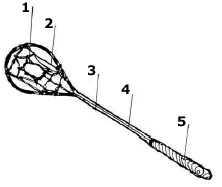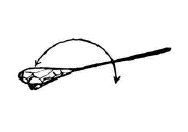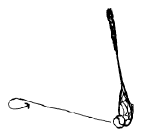TIPS
THE STICK
Basic construction of lacrosse stick:

- Central rope that can be used to adjust the depth of the netting
- The main netting
- Twisted aluminium tube
- Supporting wooden stick
- Handle
STICK HOLDING
There are two basic ways how to hold the stick handle:

On picture No. 1 you see hand grasping the stick with show finger placed on flat side of the handle.

Picture No. 2 shows hand holding the handle with the show finger slightly bent around the stick.
PASS RECEIVING

This picture shows you in very simplified form the basic movement with which you "operate" the stick. The principle is based on turning the stick over to the position where the ball can't fall out from the netting. Turn the stick over properly but no more than 180°. Doing this might be difficult for you in the beginning as it takes a bit of practising to manage.
BALL LIFTING

Another fun you'll "enjoy" will be picking up the ball from the ground. It's good to learn this efficiently as it will increase your confidence in the game. You can achieve this putting the head of stick to the ground, then you should drag the ball slowly into the netting and then quickly turn the stick to secure the ball in the netting.
STICK TREATMENT

These two pictures show us the knot used to create the whole netting of the lacrosse stick. It's important to catch the ball with stick put properly as shown on picture No. 2. Doing so you'll achieve the best seating of the ball in the netting.
STICK MAINTAINANCE
The central rope allows to adjust the depth of the netting. The less deep netting throws the ball sooner from the stick but the ball isn't so stable in the netting. In the opposite - with very deep netting is catching the ball easy but you won't be able to throw the ball so easily and at longer distance.
And now something for these who want to keep their netting long time functional. When playing during rain the netting might get wet and after drying out might contract a bit. This will affect the stick's ability to pick up and catch the ball.
The proven way how prevent this is to stretch your netting to the maximum with the central rope, wet the netting, put a ball into the netting. Then put some weight on the ball in the centre of netting to stretch it and let it dry out. Do this at home after you finish playing, of course. Glue-fixed points on the netting are important because when the knots move from their place they change behaviour of the netting